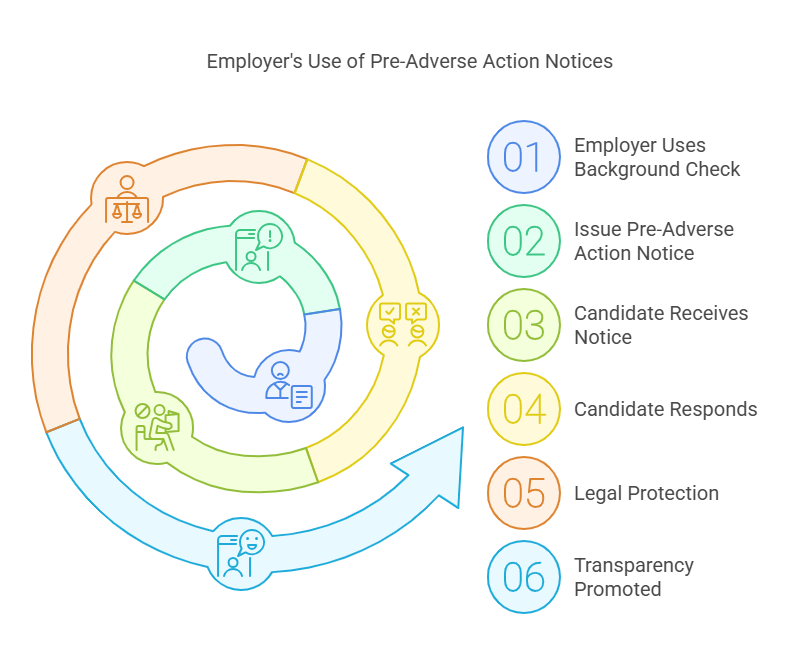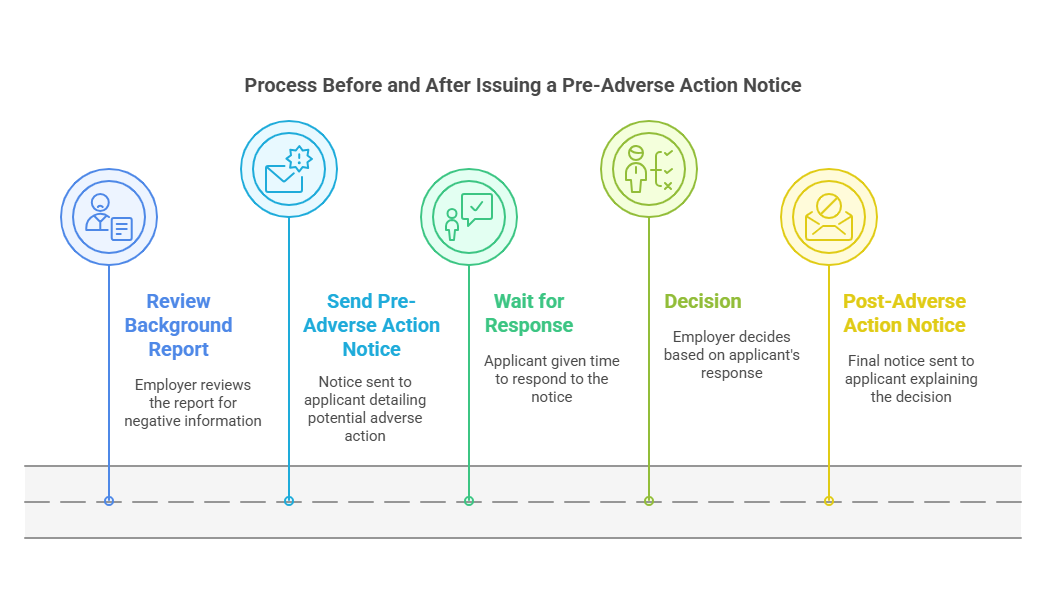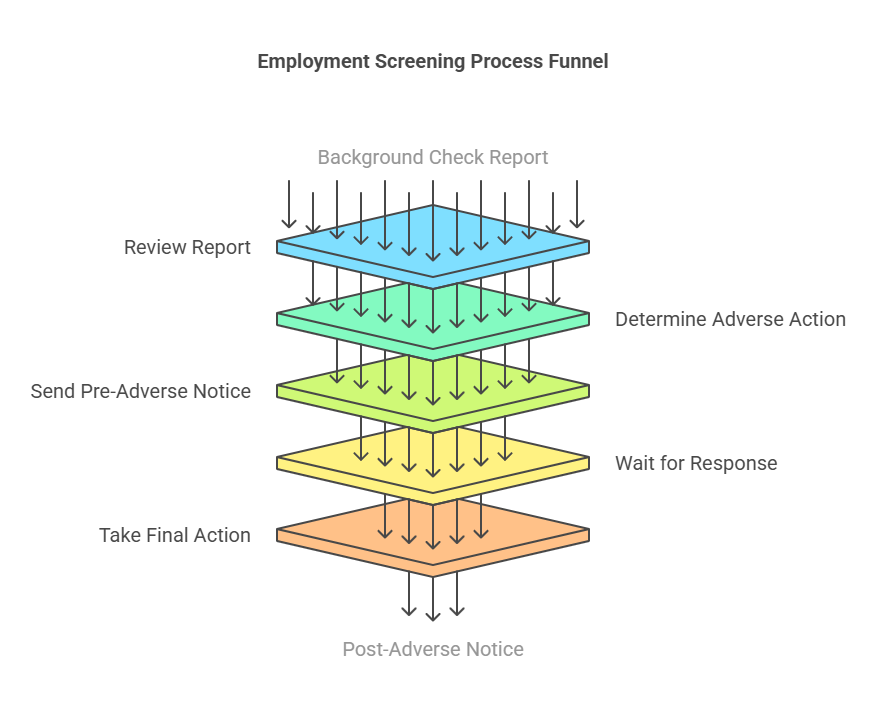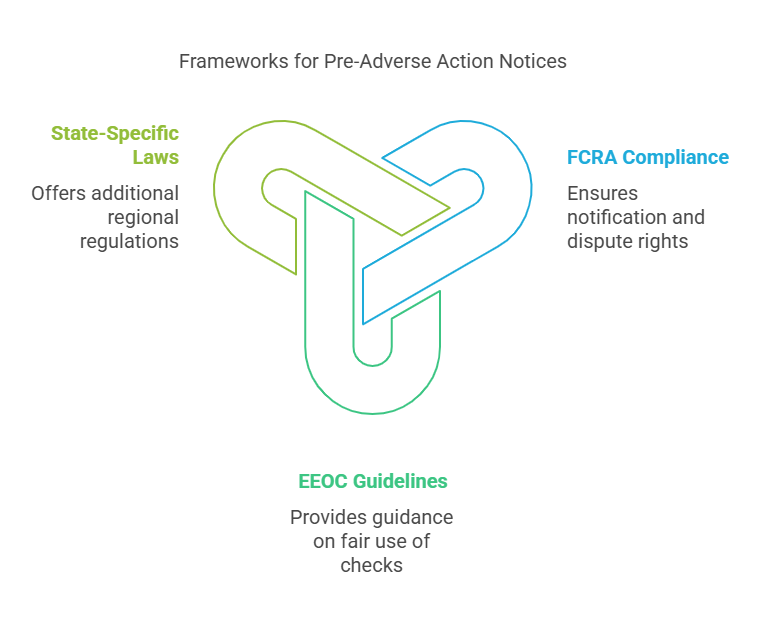Guidelines for Creating a Pre-Adverse Action Notice
Introduction and Overview of Pre-Adverse Action Notices
A pre-adverse action notice is a critical component of the background check process that protects job applicants by ensuring transparency and fairness in employment decisions. In simple terms, this notice is issued by employers when they are considering not hiring a candidate or taking an adverse action based on information found in their background check.
This notice is part of the broader Fair Credit Reporting Act (FCRA), which mandates that employers follow a specific procedure before taking any action that could negatively affect a candidate’s hiring prospects. A pre-adverse action notice provides candidates with an opportunity to review and dispute the information used in the background check that may have led to the employer’s decision.
Why Do Employers Issue Pre-Adverse Action Notices?

Employers issue pre-adverse action notices for several reasons, all of which are aimed at ensuring fairness and transparency in their hiring processes:
- Compliance with the FCRA: The FCRA requires that employers provide candidates with a pre-adverse action notice when they use background check information to potentially make hiring decisions.
- Giving Candidates a Chance to Respond: If an applicant believes the background information is inaccurate, they need the opportunity to dispute it before any final hiring decision is made.
- Reducing Risk of Legal Issues: Issuing a pre-adverse action notice helps protect employers from potential legal challenges by demonstrating they followed the proper procedures.
- Promoting Transparency: It’s crucial for employers to communicate clearly with candidates, ensuring they understand why a decision may have been made based on their background information.
The FCRA and the Pre-Adverse Action Notice
The Fair Credit Reporting Act (FCRA) is a federal law that governs the use of consumer information, including background checks, in employment decisions. The FCRA mandates that employers must follow a series of steps when they intend to make an adverse decision based on information gathered in a background report. One of those steps is the pre-adverse action notice, which must be issued before any final decision is made.
Here’s how the process works:
- Background Check Review: An employer reviews the results of a candidate’s background check.
- Decision-Making: If the information from the background check suggests a possible adverse decision (e.g., not hiring the candidate), the employer must send the pre-adverse action notice.
- Time for Response: The applicant has a set period, typically 5 business days, to dispute the information or provide additional context before the employer proceeds with the final decision.
- Adverse Action: If no dispute is filed or if the candidate cannot satisfactorily explain the discrepancies, the employer may take adverse action (e.g., not hiring the candidate).
The key point is that pre-adverse action notices offer transparency and an opportunity for the candidate to address potential errors in their report before a final decision is made.
Process Before and After Issuing a Pre-Adverse Action Notice

The process surrounding pre-adverse action notices generally follows these steps:
- Review the Background Report: The employer reviews the background report and identifies any information that might negatively affect the hiring decision.
- Send Pre-Adverse Action Notice: The employer sends the pre-adverse action notice to the applicant, detailing the reasons for the potential adverse action based on the report.
- Wait for Response: The applicant is given a period (usually 5 days) to respond to the notice with any additional information or disputes regarding the report.
- Decision: If no response is received or the applicant’s response doesn’t resolve the issue, the employer may proceed with the final adverse action decision (e.g., not hiring the candidate).
- Post-Adverse Action Notice: After taking the adverse action, the employer must send a final adverse action notice to the applicant, explaining that the decision was made based on the information in the background check.
In some cases, if the applicant provides evidence that the information was incorrect, the employer may reassess the background check results and reverse the decision.
The pre-adverse action notice provides a vital safeguard for both employers and applicants, ensuring that employment decisions are based on accurate and verified information.
Summary of Key Points
- Pre-adverse action notices are issued when employers are considering taking an adverse employment action based on a background check.
- They are a legal requirement under the FCRA, ensuring transparency and giving candidates an opportunity to dispute inaccurate information.
- The pre-adverse action notice process protects candidates and provides a structured path for resolving disputes before a final hiring decision is made.
Step-by-Step Process of Issuing a Pre-Adverse Action Notice

Issuing a pre-adverse action notice is a vital part of the employment screening process. Employers must follow specific steps to ensure they are in compliance with the FCRA and providing candidates with a fair chance to dispute any inaccurate information. Here’s a breakdown of the process:
- Review the Candidate’s Background Report:
- After receiving the background check, the employer thoroughly reviews the report to identify any potential issues (e.g., criminal records, inaccurate addresses, or discrepancies in employment history).
- Determine if Adverse Action is Needed:
- The employer determines whether the information in the background check warrants an adverse decision (e.g., choosing not to hire the applicant or rescinding a job offer).
- Send the Pre-Adverse Action Notice:
- The employer sends a formal pre-adverse action notice to the candidate. This notice should include:
- A statement that the information in the background check has led the employer to consider taking adverse action.
- A copy of the background check report that was used to make the decision.
- A notice of the candidate’s right to dispute the information in the report.
- The employer sends a formal pre-adverse action notice to the candidate. This notice should include:
- Wait for the Response:
- The candidate typically has 5 business days to dispute the information or provide additional context. This gives them enough time to contact the background check provider, clarify discrepancies, or offer explanations.
- Take Final Action:
- If the candidate does not respond or fails to resolve the dispute, the employer may proceed with the final adverse action decision, which could involve rescinding the job offer or choosing not to hire the applicant.
- Send a Post-Adverse Action Notice:
- After the final decision is made, the employer must send a post-adverse action notice to the applicant, explaining the decision and notifying them that the background check information was a factor in the final determination.
Compliance Checklist for Employers Issuing a Pre-Adverse Action Notice
Here’s a checklist to ensure compliance with the FCRA when issuing a pre-adverse action notice:
| Step | Action Required |
|---|---|
| 1 | Review the background check report thoroughly. |
| 2 | Determine if adverse action is warranted based on the report. |
| 3 | Send the pre-adverse action notice to the applicant. |
| 4 | Include a copy of the background check report with the notice. |
| 5 | Provide the applicant with the opportunity to dispute the information (typically within 5 business days). |
| 6 | Review the applicant’s response, if any, and take appropriate action. |
| 7 | Send a post-adverse action notice if the decision is final. |
Why Employers Should Provide an Opportunity to Dispute Background Information
It’s crucial for employers to allow candidates the opportunity to dispute information in their background report for several reasons:
- Fairness: Giving applicants a chance to dispute errors ensures the hiring process is transparent and fair.
- Avoiding Legal Issues: If an employer fails to provide this opportunity, they risk violating the FCRA, which can result in fines or legal action.
- Accuracy: Mistakes can occur in background checks, and applicants should be able to correct any discrepancies that might unfairly influence a hiring decision.
By offering a dispute process, employers maintain compliance with federal regulations while showing respect for the rights of the applicant.
Consequences of Failing to Comply with Pre-Adverse Action Notice Requirements
Failing to comply with the pre-adverse action notice process can lead to significant legal risks, including:
- FCRA Violations: Employers can face penalties for failing to follow FCRA procedures, including fines and lawsuits.
- Legal Action from Applicants: Candidates who are not given the proper notice may sue the employer for damages, which could lead to costly legal proceedings.
- Reputational Damage: Non-compliance can hurt an employer’s reputation, making it more difficult to attract qualified candidates in the future.
It’s essential for employers to follow the proper steps to protect both themselves and the applicants.
Summary of Key Points in Part 2
- Issuing a pre-adverse action notice is a structured process that helps employers stay compliant with the FCRA and ensures fairness in employment decisions.
- Employers must provide candidates with a chance to dispute background information before finalizing an adverse action.
- A checklist can help employers stay on track and avoid common mistakes during the process.
Legal Aspects of Pre-Adverse Action Notices

Pre-adverse action notices are heavily regulated to ensure fairness in employment decisions. Here are the key legal frameworks governing these notices:
- FCRA Compliance: The FCRA mandates that employers notify applicants before taking adverse action based on background check information. Employers must also allow time for the applicant to dispute inaccuracies.
- EEOC Guidelines: The EEOC provides additional guidance on using background checks in employment decisions, emphasizing that employers should not disqualify applicants based solely on certain types of criminal history or irrelevant information.
- State-Specific Laws: Some states have additional regulations on how background checks are used, including what information can be considered and how long an employer must wait before taking action.
FAQs about Pre-Adverse Action Notices
Here are answers to some common questions about pre-adverse action notices:
What is the Difference Between a Pre-Adverse Action Notice and an Adverse Action Notice?
-
- A pre-adverse action notice is sent before a final decision is made, allowing the applicant to dispute the background information. An adverse action notice is sent after the final decision is made, informing the applicant that they will not be hired due to the background check results.
How Long Does an Applicant Have to Respond to a Pre-Adverse Action Notice?
-
- Typically, applicants have 5 business days to dispute the information in the background check before the employer takes final action.
Do All Employers Need to Issue a Pre-Adverse Action Notice?
-
- Yes, employers must issue a pre-adverse action notice if they are using background check information to make an employment decision, in accordance with the FCRA.
What Happens If an Applicant Disputes Information in a Background Check?
-
- The employer must review the dispute and decide whether to proceed with the hiring process. If the dispute is valid, the employer may reverse the decision.
Can an Employer Still Take Adverse Action if the Applicant Doesn't Respond to the Notice?
-
- Yes, if the applicant does not respond within the specified time frame, the employer may proceed with the adverse action.
Conclusion
Issuing a pre-adverse action notice is a crucial step in maintaining a fair, compliant, and transparent hiring process. By following the FCRA guidelines and providing candidates with the opportunity to dispute discrepancies, employers can avoid legal issues and foster trust with potential employees. With the help of a reliable service like Precise Hire, employers can navigate the complexities of pre-adverse action notices and ensure they remain compliant while making informed decisions.
